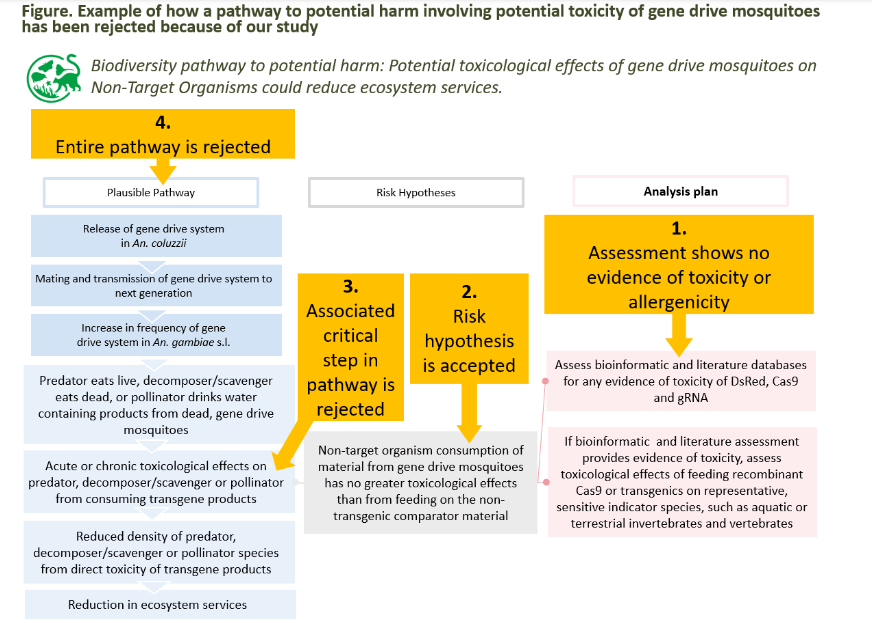Assessment of the potential for toxicity and allergenicity from our gene drive mosquitoes

I’m pleased to share a recent publication in Malaria Journal which I co-authored with Dr John Connolly that assesses the potential for toxicity and allergenicity of Target Malaria’s gene drive mosquitoes.
Previously, the first stage of an environmental risk assessment called ‘problem formulation’ was conducted to identify potential harms to protection goals for the environment, and human and animal health, from simulated releases of our doublesex-based population suppression gene drive in Anopheles gambiae sensu lato (s.l.) in West Africa. That analysis identified 46 plausible pathways to potential harm. In nine of those pathways, increased allergenicity or toxicity was postulated as the cause of the potential harm. We have spent the past three years evaluating these pathways using bioinformatic and literature assessments and found no convincing evidence to suggest that the newly introduced products that are produced in our gene drive mosquitoes are allergens or toxins. Here, I would like to explain why by summarising our latest publication.
“Taken together, our results provided no convincing evidence to support the idea that the three molecules newly introduced and expressed from our gene drive mosquitoes would be allergenic or toxic.” – Alima Qureshi
There are three molecules that have been newly introduced and are made, or ‘expressed’, in our gene drive mosquitoes as a result of their genetic modification, but which are not expressed in unmodified mosquitoes. These are: ‘DsRed’, ‘Cas9’ and ‘guide RNA’. Understanding the modes of action of these molecules can help us evaluate whether any of the biological functions of the three molecules have the potential to cause toxic or allergic effects. Two of these molecules are proteins: DsRed is a fluorescent marker that allows us to identify our gene drive mosquitoes from unmodified ones, and Cas9 is an enzyme called a ‘nuclease’ that cuts DNA. A separate class of molecule called a guide RNA binds to the Cas9 to direct it to the specific targets in the mosquito genome that we wish to cut to facilitate our gene drive mechanism. When we analysed publications from previous studies on Cas9, DsRed, or RNA, we found no convincing evidence to suggest that they might contain toxic or allergenic properties for humans or other animals. We also searched previously published studies for any evidence of histories of safe use of these three molecules. Among many examples, Cas9 has already been used in therapeutic applications in humans, and DsRed has previously been used in other mosquito strains released in the field. Cas9 protein is also present in species of bacteria that are widely used as probiotics in the production of cheese and yoghurt, as well as being frequently encountered as a natural inhabitant on human skin. In fact, many people have antibodies to Cas9, so frequent is their exposure to it. RNA is also found widely circulating in the environment and has been used extensively and safely in humans: think of the successful use of RNA vaccines to protect against COVID-19, for example. These observations all support the idea that exposure to DsRed, Cas9, or RNA should not be toxic or allergenic.
We also looked at the probability and level of exposure that humans and other animals might receive upon field releases of our gene drive mosquitoes. For the gene drive mechanism to be optimal, Cas9 is required exclusively in the reproductive cells and we have designed our mosquitoes with that in mind. Therefore, Cas9 is not expected to be expressed in the saliva of our gene drive mosquitoes so any exposure of humans to Cas9 via biting by our gene drive mosquitoes is expected to be negligible. Moreover, the levels of Cas9, DsRed, and guide RNA in any given individual gene drive mosquito would be insignificant in terms of the overall biomass found within the environment.
We also conducted investigations at the ‘bioinformatic’ level. Proteins are made up of chains of much simpler building blocks called amino acids, while RNA is made up of chains of building blocks called nucleosides. The amino acid sequence of proteins causes them to fold into characteristic three-dimensional structures that bestow specific functions on them. For proteins that are toxins, those characteristic shapes can help to produce their toxic effects. RNA, on the other hand, could be toxic by binding to either DNA or RNA of the cell to interfere with the expression of genes, including those that might safeguard the cell from toxic or allergenic reactions. We took the amino acid sequences of Cas9 and DsRed and searched a variety of bioinformatic databases for any similarities with the sequences of the tens of thousands of known toxins or allergens and used the nucleoside sequence of the guide RNA to assess whether it could interfere with gene expression in humans or other animals such as Anopheles mosquitoes. Using these bioinformatic approaches, we found no convincing evidence to suggest that any of the three molecules could be toxic or allergenic.
Taken together, our results provided no convincing evidence to support the idea that the three molecules newly introduced and expressed from our gene drive mosquitoes would be allergenic or toxic. These data have therefore allowed us to accept the risk hypothesis that products newly introduced and expressed in our gene drive mosquitoes would not cause increased allergenicity or toxicity and, consequently, they allow us to reject nine of the total of 46 plausible pathways to potential harm.

Hence, our newly published evaluation indicates that environmental releases in West Africa of our population suppression gene drive for malaria vector control, should they be approved, would not result in any increased allergenicity or toxicity in humans and animals.
